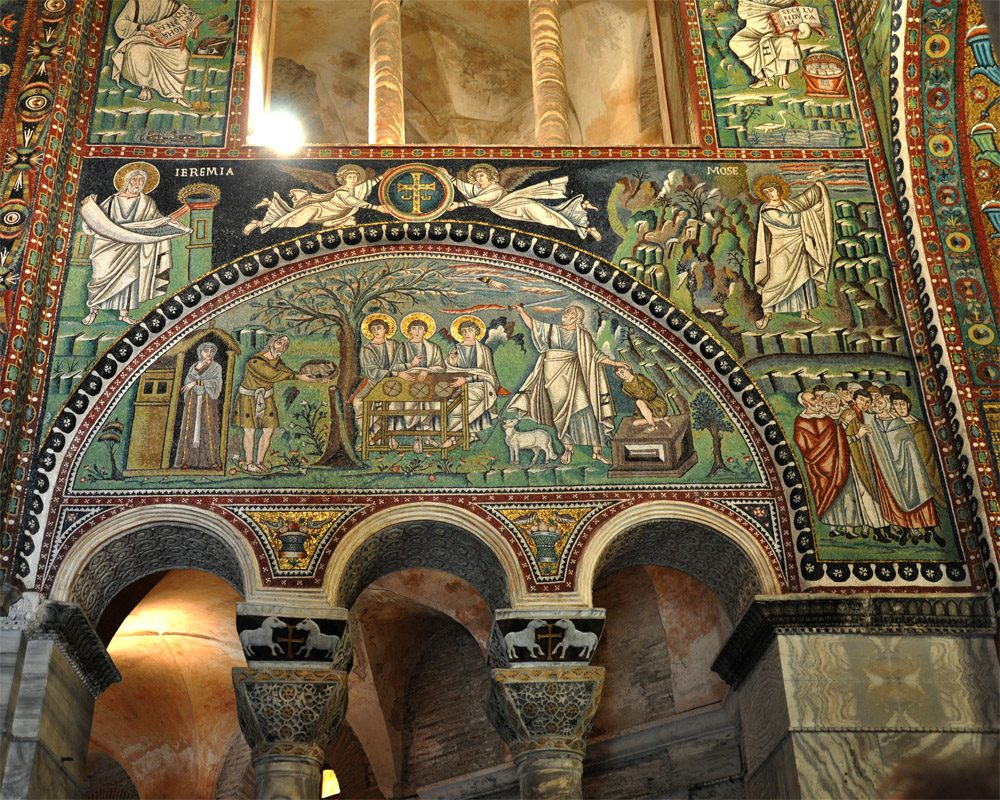The Hospitality of Abraham

6th century
Mosaic
Basilica of San Vitale, Ravenna
This and the mosaic on the facing wall focus on sacrifices in the Old Testament that precede and are types of the sacrifice of Christ on the Cross. Appropriately, they are on the left and right sides of the area that precedes the presbytery, where the Eucharistic liturgy offers the sacrifice of Christ to the Father.
THE MAIN LUNETTE
The lunette illustrates the Hospitality of Abraham on the left and center (Genesis 18:1-15) and the Sacrifice of Isaac on the right (Genesis 22:1-18). The juxtaposition points to the significance of the two events as types of the sacrifice of Christ and the sacrifice of the Mass. The prominence of the loaves, each with an incised cross, underlines the typology. (At the time, the bread consecrated in the Eucharist was in the form of loaves offered by the faithful – see McLachlan, 350.) The typology is also referenced by the sacrificial animals – the lamb offered by Abraham on the left, the ram on the right that will be substituted for Isaac, and the lambs or sheep adorning the capitals of the columns below.
JEREMIAH AND MOSES
Jeremiah and Moses stand in the corners above the mosaic. I would suggest that the reason for picturing them in particular has to do with the theme of covenant. God's covenant with Abraham in Genesis 17:1-4 is sealed by the two episodes in the lunette, the promise of a son and Abraham's willingness to sacrifice that son: "because you acted as you did in not withholding from me your beloved son, I will belss you abundantly and make your descendants as countless as the stars…." (Genesis 22:16-17). The covenant with Moses, given along with the commandments in Exodus 19:1-6, is a development of the one with Abraham. And to Jeremiah the Lord promises a new covenant that will be deeper and more intimate than the one with Moses because "I will write it in their heart: and I will be their God, and they shall be my people (31:31-33)."
THE EVANGELISTS
Above the lunette and the two portraits are images of two of the evangelists, St. John on the left and St. Luke on the right. (This photo does not show them completely, but see the detail photos below.) The other two evangelists are on the facing wall.
THE LOWER RIGHT CORNER
At the lower right corner of the lunette is what could be either the Kiss of Judas or Jacob's embrace of his favored son Joseph: a young man being kissed by an old one, with eleven others standing close by. It is not clear why a Kiss of Judas should be here among the Old Testament scenes, unless it was an adumbration of the sacrifice that would occur the following day. A scene with Joseph might be more appropriate, as he is considered a type of Christ (see Catholic Encyclopedia, s.v. "Joseph"). The corresponding scene in the lower left corner of the mosaic on the wall facing this one has Moses feeding one of his sheep with his right hand while he holds the scroll of commission in his left.
JESUS CHRIST, THE CENTER OF ALL
Jesus Christ, presented symbolically as a jeweled cross in the clipeus held by the angels, is appropriately the central visual element linking together all the portraits and episodes in this composition. He is the Lamb of God whose sacrifice contains and gives meaning to all other sacrifices, who was kissed by his betrayer, and who accepted the Father's commission to save his people.
Have a look at these detail photographs for further commentary:
View the arch in full resolution.
View the mosaic on the facing wall.
Read more about images of Abraham, Moses, St. John the Evangelist and St. Luke.
Photographed at the basilica by Richard Stracke, shared under Attribution-NonCommercial-ShareAlike license.